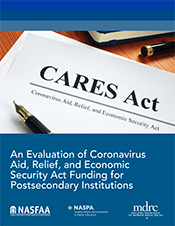An Evaluation of Coronavirus Aid, Relief, and Economic Security Act Funding for Postsecondary Institutions
 In March 2020, Congress passed the Coronavirus Aid, Relief, and Economic Security (CARES) Act, an economic stimulus package designed to address the nationwide economic crisis created by the global COVID-19 pandemic. In Fall 2020, the National Association of Student Financial Aid Administrators (NASFAA), NASPA—Student Affairs Administrators in Higher Education, and MDRC, using generous grant funding, set out to evaluate these funds and how they affected students.
In March 2020, Congress passed the Coronavirus Aid, Relief, and Economic Security (CARES) Act, an economic stimulus package designed to address the nationwide economic crisis created by the global COVID-19 pandemic. In Fall 2020, the National Association of Student Financial Aid Administrators (NASFAA), NASPA—Student Affairs Administrators in Higher Education, and MDRC, using generous grant funding, set out to evaluate these funds and how they affected students.
In this project, we surveyed college and university administrators and conducted administrator and student focus groups to answer the following research questions:
- What were the successes and challenges related to the allocation, application, and distribution of CARES Act funds to institutions, including timing, communication, and processes?
- Which essential roles and functions are needed to award and disburse the emergency aid at the institutional level, and what patterns emerged in the strategies institutions used to distribute their CARES Act and subsequent emergency aid funds?
- What measures did colleges take to ensure they allocated money and resources quickly and equitably, and which strategies were deemed most effective in ensuring students who most needed the funds received them?
- How did institutions commonly allocate CARES Act emergency grants to meet their institutional needs and support their institutional goals?
- How did students use the funds they received? Did students report feeling these funds helped them continue their education, and/or did they identify additional needs?
The results included:
Considerations for Financial Aid Policy1
- Consideration 1: Base the allocation formula on student headcount enrollment that includes distance education students.
- Consideration 2: Use the grants.gov website for requesting funds and the G5 system for disbursing emergency grant funds to institutions, and ensure funds are distributed to institutions promptly.
- Consideration 3: Make congressional intent clear while keeping allowable uses of funds broad.
- Consideration 4: Improve ED guidance and training, and deliver both promptly.
- Consideration 5: Make reporting requirements clear.
- Consideration 6: Exempt emergency aid from estimated financial aid (EFA).
- Consideration 7: Continue to develop emergency aid programs outside the confines of HEA Title IV programs.
Recommendations for Emergency Aid Programs2
- Recommendation 1: Improve communication and clarity for students.
- Recommendation 2: Assess institutional efforts and continue refining the process.
- Recommendation 3: Ensure equity is a guiding principle.
Recommendation 4: Deliver timely responses and payments to students. - Recommendation 5: Broaden eligible emergency aid expenses.
Download Full Survey Results and Data Tables (PDF)

![]()
![]()
1 The financial aid policy considerations contained within are those of NASFAA and do not necessarily reflect positions or policies of the Bill & Melinda Gates Foundation, NASPA, or MDRC
2 The emergency aid policy/program recommendations contained within are those of NASPA and do not necessarily reflect positions or policies of the Bill & Melinda Gates Foundation, NASFAA, or MDRC.
Publication Date: 7/14/2021



